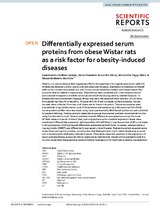| dc.contributor.author | Gabuza, Kwazi B. | |
| dc.contributor.author | Sibuyi, Nicole Remaliah Samantha | |
| dc.contributor.author | Mobo, Mmabatho Peggy | |
| dc.date.accessioned | 2020-12-10T12:20:39Z | |
| dc.date.available | 2020-12-10T12:20:39Z | |
| dc.date.issued | 2020 | |
| dc.identifier.citation | Gabuza, K. B. et al. (2020) .Differentially expressed serum proteins from obese Wistar rats as a risk factor for obesity-induced diseases. Scientific Reports,10(1),12415 | en_US |
| dc.identifier.issn | 2045-2322 | |
| dc.identifier.uri | https://doi.org/10.1038/s41598-020-69198-2 | |
| dc.identifier.uri | http://hdl.handle.net/10566/5496 | |
| dc.description.abstract | Obesity is a chronic disease that negatively affects life expectancy through its association with life-threatening diseases such as cancer and cardiovascular diseases. Expression proteomics combined with in silico interaction studies are used to uncover potential biomarkers and the pathways that promote obesity-related complications. These biomarkers can either aid in the development of personalized therapies or identify individuals at risk of developing obesity-related diseases. To determine the serum protein changes, Wistar rats were fed standard chow (low fat, LF), or chow formulated high fat (HF) diets (HF1, HF2 and HF3) for 8 and 42 weeks to induce obesity. Serum samples were collected from lean and obese rats at these time points. | en_US |
| dc.language.iso | en | en_US |
| dc.publisher | Springer Nature | en_US |
| dc.subject | Computational biology and bioinformatics | en_US |
| dc.subject | Biomarkers | en_US |
| dc.subject | Obesity | en_US |
| dc.subject | Wistar rats | en_US |
| dc.subject | Serum protein | en_US |
| dc.title | Differentially expressed serum proteins from obese Wistar rats as a risk factor for obesity-induced diseases | en_US |
| dc.type | Article | en_US |

